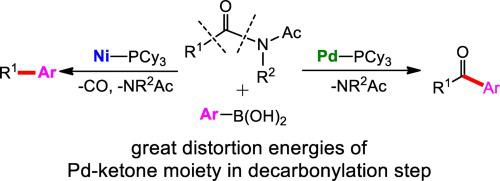Computational and Theoretical Chemistry ( IF 2.8 ) Pub Date : 2020-06-03 , DOI: 10.1016/j.comptc.2020.112889 Jian Liu , Menghang Ling , Hujun Xie

|
The reaction mechanisms for palladium-catalyzed acyl and nickel-catalyzed biaryl Suzuki-Miyaura cross-coupling of N-acetyl-amide with arylboronic acid have been investigated via density functional theory (DFT) calculations. The calculations demonstrated that two catalysts Ni/PCy3 and Pd/PCy3 lead to different catalytic cycles. In the case of Ni/PCy3 catalyst, the favorable catalytic cycle to give product biaryl contains four steps, oxidative addition, transmetallation, decarbonylation, and reductive elimination. In the case of Pd/PCy3 catalyst, the favorable catalytic cycle to yield product ketone proceeds by three steps, oxidative addition, transmetallation and reductive elimination. Present calculations are consistent with the experimental results and could provide new insights into the development of Pd and Ni catalysts for highly selective reactions.
中文翻译:

Pd和Ni催化剂催化N-乙酰基酰胺与芳基硼酸的酰基和脱羰基Suzuki-Miyaura偶联的化学选择性机理:DFT计算的见解
通过密度泛函理论(DFT)计算研究了钯催化的酰基和镍催化的联芳基Suzuki-Miyaura交叉偶联N-乙酰基酰胺与芳基硼酸的反应机理。计算表明,两种催化剂Ni / PCy 3和Pd / PCy 3导致不同的催化循环。在Ni / PCy 3催化剂的情况下,产生产物联芳基的有利催化循环包含四个步骤:氧化加成,金属转移,脱羰基和还原消除。对于Pd / PCy 3催化剂,产生产物酮的有利催化循环通过氧化加成,金属转移和还原消除三个步骤进行。目前的计算与实验结果是一致的,并且可以为用于高选择性反应的Pd和Ni催化剂的开发提供新的见解。



























 京公网安备 11010802027423号
京公网安备 11010802027423号